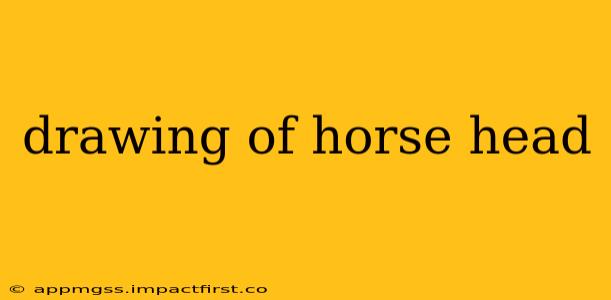Drawing a horse's head can seem daunting, but with the right approach and understanding of its anatomy, you can create a realistic and expressive portrait. This guide breaks down the process into manageable steps, catering to both beginners and more experienced artists. We'll cover everything from basic shapes to refining details, ensuring you can capture the beauty and power of this magnificent animal.
What are the Basic Shapes of a Horse's Head?
A horse's head isn't just a random collection of features; it's built upon underlying foundational shapes. Think of it as a combination of simple geometric forms that you can gradually refine. The basic structure can be simplified into a slightly elongated oval for the skull, with smaller ovals or circles for the eyes, nostrils, and muzzle. These initial shapes act as a scaffolding, guiding your subsequent additions.
How Do I Draw the Horse's Eye?
The eyes are a crucial element in conveying emotion and realism. They're not perfect circles; they're more almond-shaped, slightly slanted, and relatively large compared to the overall head size. Observe how the light reflects off the eye, creating highlights and shadows that add depth and life. Pay attention to the tear duct and the subtle wrinkles around the eye. Remember to keep the eyes symmetrical to maintain balance.
How Do I Draw a Horse's Muzzle?
The muzzle is the horse's lower face, including the nostrils and lips. Start by drawing a slightly rounded, somewhat rectangular shape for the general area. Then, add the nostrils, which are oval and slightly flared. The lips are relatively thin and can curve slightly upwards or downwards depending on the horse's expression. Pay close attention to the subtle curves and wrinkles around the muzzle.
How Do I Draw a Horse's Mane and Forelock?
The mane and forelock greatly contribute to the overall appearance of the horse's head. The mane typically flows down the neck, and the forelock hangs over the forehead. Consider the texture and direction of the hair, whether it's long and flowing or short and clipped. You can add individual strands for detail or use quick strokes to suggest overall volume and movement.
How Do I Draw the Ear of a Horse?
Horse ears are quite expressive, capable of conveying a wide range of emotions. They're generally long, pointed, and mobile. Start with a curved, slightly triangular shape for the overall structure. Then add details like the inner ear and the subtle folds of skin. Pay attention to the positioning of the ears; their position can significantly alter the horse's expression.
What Are Some Tips for Drawing Horse Hair?
Drawing realistic horse hair can be challenging. Avoid individual strands, particularly in larger areas. Instead, use light, short strokes to suggest the texture and flow of the hair. Vary the direction and density of your strokes to create natural-looking volume and movement. This technique helps build up the appearance of the fur without overwhelming the drawing.
What Are Some Common Mistakes to Avoid When Drawing a Horse's Head?
- Incorrect proportions: Ensure that the features of the horse's head are proportional to each other and the overall head shape. This often requires multiple reference images.
- Lack of realism in the eye: Capture the depth and shape of the eye correctly. Avoid overly simple or cartoonish representations.
- Overly flat muzzle: The muzzle requires detail and should not appear overly simplistic. Consider the textures and subtleties.
- Ignoring the muscles: The underlying musculature of the horse's head influences the overall shape. Study anatomical references to understand this better.
By following these steps and practicing regularly, you'll improve your ability to draw realistic and expressive horse heads. Remember that practice and observation are key to mastering this skill. Use reference images for guidance, and don't be afraid to experiment with different techniques. The more you draw, the better you'll become at capturing the unique beauty and character of these magnificent animals.
